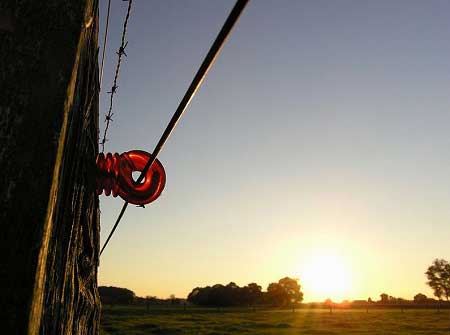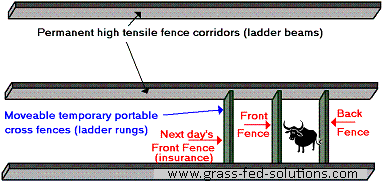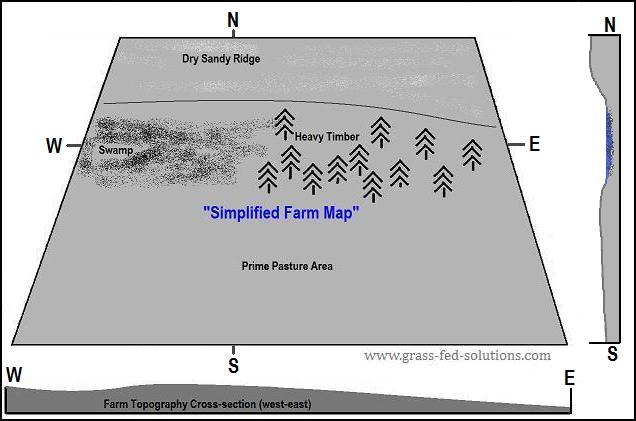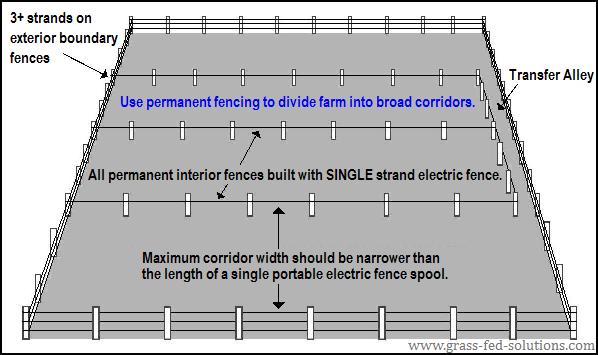The Smart Electric Fence Grid
Electric Fence Installation (design + layout)

Image Credit: Guido Gerding
This seven-part article about electric fence installation will explain how to plan and build your smart electric fence grid using a combination of permanent and portable electric fencing.
Combining permanent and portable electric fencing is the most efficient and most cost-effective cattle fencing solution for managing your rotational grazing program. This powerful combination is also the simplest and easiest method to create daily pasture moves in your pasture rotation.
- Part I explains how to lay out your permanent electric fence corridors to create the backbone of your grazing rotation.
- Part II explains how to build these permanent electric fences.
- Part III explains how to subdivide these permanent corridors using temporary portable electric cross-fences to create flexible daily grazing slices.
- Part IV provides construction tips for these portable electric cross-fences.
- Part V explains how to integrate your livestock water system with your electric fence installation so every grazing slice, no matter how big or how small, will have access to drinking water.
- Part VI explains the how to customize your electric fence and water system for grazing during the winter months.
- Part VII provides tips on how to keep your electric fences working effectively even when the ground is frozen and there is deep snow piling up in the fields.
Introducing the "smart" electric fence grid
An electric fencing grid that uses a combination of permanent and portable electric fences is incredibly flexible. You can set up or move your cross-fences within minutes anywhere you like within your permanent electric fence corridors. This makes it extremely easy to create a daily pasture rotation that can speed up or slow down to match grass growth because you are not tied to fixed pasture sizes.
The flexibility of this type of electric fence installation also allows you to turn your cattle into an important farm management tool. The ability to change the size and location of your pasture slices, on a whim, allows your grazing cattle to be used as a pasture management tool to improve pasture quality, increase grass yields, improve soil fertility and soil moisture, protect riparian areas, and even control pasture weeds.
Using a combination of permanent and portable pasture fences in your electric fence installation also has dramatic benefits for your beef cattle management. The increased flexibility and fine-tuned control over your pasture rotation will increase cattle weight gains on pasture, reduces disease pressures, creates higher quality pastures for grass-finishing, reduces winter feed costs, and more, all of which are explained further in the beef cattle management article.
This immense management flexibility is created without cluttering up your farm with a labyrinth of wires. In fact, you require very, very little electric fencing to get the job done. With just a little bit of planning before you begin construction of your electric fence installation, you will have by far the lowest-cost cattle fencing possible, your fields will remain open and uncluttered, and you will have by far the greatest flexibility in your rotational grazing management that you can possibly have.
That's why I like to think of this as the 'smart' electric fence grid, because your electric fence installation essentially becomes an extension of your mind - able to respond to whatever grazing needs, management ideas, production goals, or market opportunities that come your way simply by moving your cross-fences to a new location. It's truly a fencing solution for all beef producers, for all cattle (whether you raise cow/calf, stockers, breeding stock, grass-finishing animals, or all of the above simultaneously), and for all seasons!
Planning your smart electric fence grid
Planning your electric fence installation is divided into 5 major steps:
|
Once you've completed these five steps it becomes very easy to plan your grazing strategies for each season, plan your calving season, plan your health management, weaning, grass-finishing, and more. It's simply a matter of drawing your plan for each of these business components directly onto your infrastructure maps, either by using transparent overlays on your base farm map, or by creating map layers in a computer photo-editing software program. For tips and guidance on how to set up your map layers, read this quick article about how to organize and draw your cattle management plan.
Complete all the steps of your farm plan ON PAPER before setting out to build your first pasture fence. Plan first, build later...
Putting it all together:
By the time you are done planning your electric fence installation and your farm business plan, you should have the following overlays for your base farm map (excluding any layers that do not apply to your operation):
|
You can see an example of an actual farm plan with each of these map layers by following the link.
Step-by-Step Electric Fence Planning - Permanent Corridors
Step # 1: Create a clean simple base map of your farm:
- Draw a simplified map of your farm. Air photos do not make good base maps because they are too cluttered and busy. Air photos are wonderful for locating features, but do not draw on the air photo itself. Either draw your base map on clean white paper, or better yet, draw it on a transparent overlay placed over your air photo so you can add or remove your air photo at any time to make adjustments to your transparencies. Refer to the air photo to annotate your base map with simplified topographical features and to keep your map to scale, but then remove the air photo before moving on to the next step of your planning process. This simplified view is much less cluttered than an air photo, making it much easier to plan your pasture fences and water systems.
- To create your transparent overlays I recommend using velum for hand-drawn maps because it's much thicker and more durable than tracing paper and can typically be bought in large sheets at least 17x22 inches in size. You may need to go to a drafting supply store as not all office supply stores carry Velum. Or, better yet, use a computer software drawing program that allows you to create multiple map layers that can be individually edited and stacked over your air photo and base map. In the brief article about how to organize and draw your cattle management plan, I discuss how to use a computer-based drawing program to create your farm planning maps and provide my recommendations for which programs to use.
- The base map should be drawn to scale so you can measure fence distances and easily calculate your material requirements when you are ready to begin construction of your electric fence installation.
Show key topographical features:
- Water features
- Important differences in soil type
- Timber, forest areas, scrub brush, etc.
- Prime pasture areas
- Ridges, gullies, etc.
- DO NOT include existing pasture fence infrastructure on your base map. I recommend reading this brief article on how to deal with pre-existing fence infrastructure during your electric fence planning process if your farm already has some existing cattle fences.
- Include a rough elevation cut-out across both directions of your farm. This is important for planning your livestock water system and helps suggest ideal locations for your permanent electric fence corridors.
Step # 2: Divide your land into broad corridors using permanent electric fencing:
Create a new transparent map overlay on top of your base map from Step # 1 above to draw your broad electric fence corridors:
- Divide your land into broad permanent electric fence corridors. These will be built using high-tensile 12-guage wire and permanent wooden posts. These corridors direct the flow of your pasture rotation. You'll create daily pasture slices by dividing these corridors using portable electric fencing and temporary step-in fence-posts, which I'll discuss in Step # 3. These broad corridors provide power to all corners of your farm, which you'll hook onto later with your portable electric fence subdivisions.
- Internal pasture fences should usually be designed as single strand electric fences.
- External farm boundary fences in your electric fence installation should be at least 3-strand to function as a physical barrier in case of a power failure to prevent cattle escaping onto highways or neighboring farms.
- Build transfer alleys to create a seamless pasture rotation around your entire farm. Transfer alleys also allow you to easily move cattle back and forth between the corral area and any pasture on the farm with relative ease.
- Corridors should be slightly narrower than the length of a single spool of portable electric wire. Check with your electric fence dealer to find out what wire lengths are available on portable wire spools before planning your permanent fence corridors. Common wire lengths on pre-wrapped portable electric fence spools are 200m (656'), 400m (1312'), 500m (1640') and 1000m (3300').
Divide land in such a way that you can graze different topographical features separately:
- Prime pastures should be separated from dry areas.
- Swamps or forested areas should be fenced separately from grass pastures.
- Pastures with firm, well-drained soils should be fenced separately from soils that get very muddy after heavy rains or during the spring thaw.
- Wind-blown ridges that are generally snow-free or have a thin snow cover should be fenced separately from sheltered areas or areas that accumulate heavy snow drifts in the winter.
- DO NOT draw on your base map. Use removable transparencies or overlays to plan your corridors so you can easily edit your pasture fence plan. There will be a large number of separate overlays before you are done your planning process, each showing a different part of your farm business plan. You don't want everything planned on the same map layer because it will completely clutter your plan. Each map layer will be applicable to different seasons and reflect different parts of your management strategy, so you don't need to see them all at once.
Fence layout - where to put your electric fence corridors
Your electric fence grid is a direct reflection of how you intend to manage every single aspect of your cattle operation. Fence layout is so important that it essentially functions as the 3-dimensional business plan of your entire farm - it is the blueprint to your entire business.
Grazing strategy, calving, herd health, winter feed, watering systems, etc - collectively they determine how, why, and where you will build each and every electric fence corridor on your farm. Construction of your electric fence installation should only begin after you can 'see' how your entire production year will play out in the series of map overlays that you are building as part of your electric fence planning process.
The list below is a sample of all the questions that you need to address in your farm plan and on your map overlays before you plant your first fence post. The answers to every single one of these questions will be reflected in the layout of your electric fence installation.
The example farm plan shows how all of these questions have been addressed in a simple, neat package by that pre-plan each stage of the operation.
The list below is a sample of some of the questions that your farm maps and electric fence installation should consider:
How will you provide your cattle with adequate water in both summer and winter from every part of your pasture rotation?
What are your calving, breeding, and weaning strategies and when are they scheduled to happen during the production year?
How will you source your cattle (i.e. are you buying grazers or raising your own calves)?
If you are routinely buying new cattle for rotational grazing, how will you settle them during the disease-prone first weeks after arrival?
What is your strategy to train new cattle to electric fences?
What is your grass-finishing strategy?
How do you plan to market your cattle?
What is your plan for maintaining and improving your pasture productivity?
How will you manage your soil fertility?
How will you manage your soil moisture and irrigation requirements?
What is your weed management strategy?
What is your disease treatment protocol?
What are your cattle handling strategies, such as:
what is your strategy to accomplish pasture moves?
how will you sort sick animals from the herd?
how and where will you quarantine sick animals?
how will you sort cattle from the herd on slaughter days?
what is your corral layout and how will your cattle reach it from each and every pasture on the farm?
How do you plan to provide adequate nutrition for your cattle during the winter?
How will you prepare your pastures for winter grazing?
How will your rotational grazing strategy change after the growing season ends?
Do you have a monthly forage analysis program and do you work with a livestock nutritionist to manage your winter grazing program?
Do you know how to monitor body condition scores so you know how to keep cattle safe during winter grazing?
Where will your cattle be during the muddy spring thaw to reduce disease pressure and prevent pasture damage?
How will you maintain a drought reserve?
What is your drought plan? Your drought plan should include a feed and/or grazing reserve, your drought response protocol, and financial reserves to allow you to survive the financial consequences of drought or disaster.
And a final point:
Is your overall farm plan and electric fence installation simple enough that you can easily get someone else to execute your plan for you using the maps and business plan you have created?
This final point - simplicity - is an important litmus test - not only to prepare for the unexpected - but also as an extremely important litmus test for yourself.
If you need a degree in rocket science to follow the complicated plan you have created, you won't follow it or some unexpected oversight will bring the whole thing crashing down around you. Keep it simple!
Note how simple the grazing rotation is in this example farm plan - the flow of cattle is simple and easy to understand and the fence layout is very basic. I could give that plan to anyone familiar with grass-fed grazing principles and they would be able to manage that farm without exchanging a single word with me. That's how simple your finished plan should be. If it's complicated, go back to the drawing board and keep reworking your plan.
It's not enough to figure this stuff out as you go; that's how you wind up with expensive band-aids and countless avoidable challenges that drive up production costs. It's easy to blame disease on bad weather, herd handling difficulties on crazy cows, and insufficient forage on an absence of rainfall, but in reality these are all symptoms of bad planning; symptoms of a fence layout and grazing strategy that failed to account for the expected.
Cattle behave according to predictable behavioral patterns and respond to their environment in predictable ways. Weather is never average - eventually it will always test the extremes and you better be prepared! Diseases are caused by predictable disease mechanisms - prevention is all about planning ahead. And profit margins can be pre-planned to account for adversity. It all boils down to planning. Your fence layout is merely the physical reflection of all your plans.
If you address all these questions during the design stage of your electric fence installation, your electric fence grid and rotational grazing strategies will be your most important tools to allow you to consistently and profitably produce high-quality, tender, flavorful beef.
I encourage you to read my book, Grass-fed Cattle: how to produce and market natural beef, for a comprehensive overview of all the considerations (and their management solutions) that you need to address in your grass-fed beef business plan.
Before moving on to the portable electric cross-fences that are used to control the 'flow' of your cattle through your pasture corridors (discussed in Part III), there are a few important construction tips for building your permanent electric fences that I'd like to share with you:
Related Articles:From the Smart Electric Fence Grid series:
Other articles:
(Disclosure: I get commissions for purchases made using Amazon links in my post.) And when you're ready to start planning your cattle farm, check out my book: Grass-Fed Cattle: How to Produce and Market Natural Beef. Use the links below to explore my book and read reviews on Amazon: 
|
|
Share: |
|





